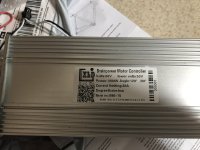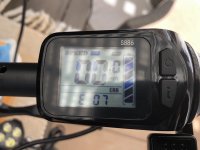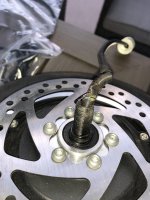simonen said:
This was my first attempt to run the motor having just received the controller. So it appears to have arrived this way. The seller has offered to provide a partial refund, but I will need to take responsibility to get it fixed and I do not feel like waiting another month for a replacement.
I would recommend removing the side cover, pulling the cable into the motor thru the axle, then cut out the damaged section (it's probably half inch or more either side of that spot, just in case) and reconnect and reinsulate the wires.
This is a common damage on shipping motor wheels, as they rarely put much packing in there, and sometimes none. Usually nothing to protect the axle. A very few do, but they have to charge a lot more for shipping, as they use wooden crates or very heavy duty cardboard boxes, often multilayer, with packing shaped to fill the whole box.
On a side note, it is absolutely irritating that there is no documentation provided with the controller describing what all the connections are for or how to program it.
This is completely normal, unfortunately. I wish I had more positive information for you, however:
There are *very rare* cases of companies, like Grin Tech, that provide such information for the things they sell.
Most sellers, and even manufacturers, have, at best, a half-translated connection diagram, with wires that look somewhat similar to the wires actually on the controller you received (which generally doesn't look quite like what they advertised, because it's probably not the same kind). But more commonly, they have zero information at all, and don't care to respond to inquiries of any kind, at least not *after* they've sold you something.
To make matters worse, it seems to have only specific wheel sizes to choose from in the setup which are all too big for my wheel. My wheel is 10 inch, and the smallest choice is 16 inch.
Also very common, rather than simply following the "cycle computer' convention of inputting the *actual circumference* in mm. There is a way around it, but it is very DIY:
You could make something with a small MCU, maybe atttiny, etc., that you program with the ratio of your actual tire diameter vs the calculated diameter it's using (the difference between your actual wheel speed and what it thinks it is), and it applies that to the pulses coming in from the speed sensor and calculates the pulses to send to the controller to give the corrected speed reading. It would probably take a few to a few dozen pulses to do it, so it may not be quite realtime, but it will be close enough except at really low speeds. It can be made in hardware instead, but it's harder to change when you change tires (which changes the circumference).
simonen said:
After rebuilding the phase wires to the hub motor, everything seems to be working except I still have the error 7. Since I do not have a Hall connector coming out of the motor, could this be the issue? I was thinking about adding an external speed sensor and attach the signal wire to the white wire on the controller hall connector. Hopefully that will solve the error.
Depends on what the error actually means.
If it means the speed sensor is not connected, then connecting one will fix it. Most geared hubmotors that don't have hall sensors (and some that do) have a speed sensor built in, and a 3-wire plug for the purpose.
If it means the hall sensors aren't connected, then you'll have to connect them; if the mtoor doesnt' have any and the controller requires them, then it is not compatible with that motor. You may be able to add them to the motor, but it is much easier to use a different controller, or different motor.
Did the motor come with the controller? Or were they purchased separately from different places (or the same one)?
If they came together, they should work together, but many sellers will sell things that don't work together to the same person in the same order without bothering to tell the buyer that, even if the buyer thinks to ask.





